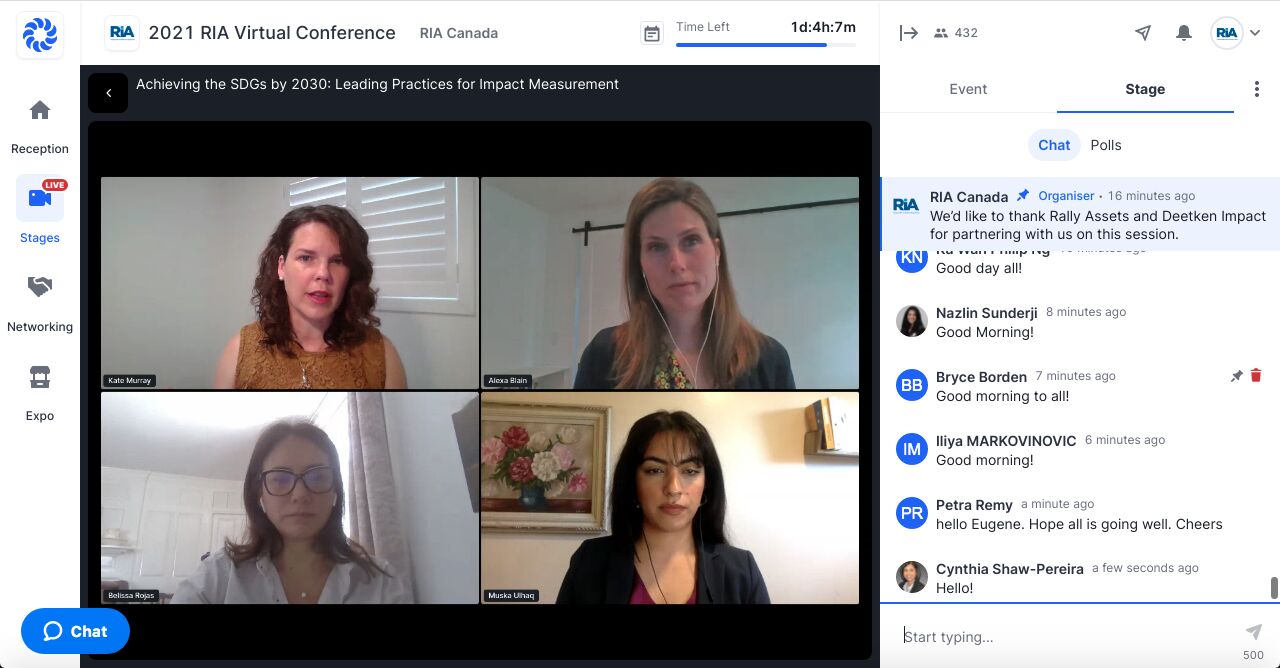
Speakers:
Muska Frackowiak, Manager, Operations and Programs, Responsible Investment Association
Alexa Blain, Co-Founder and Managing Partner, Deetken Impact
Kate Murray, Director, Impact Management, Rally Assets
Belissa Rojas, Impact Measurement and Management Lead, SDG Impact Team, UNDP
The pandemic has brought to light the interdependence of social, environmental and economic connections, and has shown the urgency to act much faster, said Belissa Rojas, Impact Measurement and Management Lead of the SDG Impact Team at United Nations Development Programme (UNDP), at the RIA conference session “Achieving the SDGs by 2030: Leading Practices for Impact Measurement.”
“Before the pandemic, we really knew that action was needed. After the pandemic, we saw the magnitude of huge inequalities and how a crisis, like COVID-19, really affects communities in different ways.”
Rojas noted that interest in ESG investing has grown, but further action is still needed.
“Although there’s an intention, we’re seeing a gap between intention and actual results. Furthermore, we don’t even know what the results are because only 1% are really reporting on what they did that’s measured, and specific metrics,” Rojas said.
“They say what’s not measured is not managed, but many things that are measured are not managed either.”
To change this, the UNDP believes that the private sector needs to shift their mindset and behaviours so that ESG or impact is embedded as a core philosophy, rather than considered an add-on.
The five dimensions of the Impact Management Project
Kate Murray, Director of Impact Management at Rally Management, shared with the audience some of the more credible tools and frameworks available for fund managers to measure and report on their impacts. One particular framework Murray highlighted was the Impact Management Project, which contextualizes the five dimensions of impact by proposing the following five questions:
- What is the impact?
- Who is benefiting? Are the beneficiaries well-served or underserved?
- How much? What is the scale of impact?
- What is the contribution or change that is occurring?
- What is the risk? More specifically, what is the risk that the impact is going to be different than anticipated?
“Ultimately, this all boils down into an assessment as to whether an investment is avoiding harm, which is reducing harmful practices,” Murray said.
Industry wary of impact washing
Conversations around greenwashing and impact washing are on the rise, leading some in the industry to wonder if greater discernment is needed when it comes to impact investing.
“There’s tremendous interest in impact investing right now and I think that can lead people to want to jump on the bandwagon,” said Alexa Blain, Co-Founder and Managing Partner at fund manager Deetken Impact.
“There has been a lot of concern around impact washing,” she added. Impact washing is basically when a company or fund tries to benefit by overstating or falsely making impact-focused claims.
“I think we need to be a little bit careful when we talk about impact washing so that we’re not creating barriers to entry to the industry or kind of gatekeeping impact. We want this to be a big tent and there’s going to be different approaches to impact,” Blain said.
“What I think is really important is transparency and accountability so that you’re saying what you’re going to do and we’re not misleading or misrepresenting investment approaches to investors, which certainly would be quite damaging to the impact industry as a whole.”
When evaluating an impact fund or opportunity, Blain recommends asking what their impact management process is, and inquiring whether there is a team or professional — and this doesn’t have to be a full-time person — who is responsible for impact management.
“You want to make sure that they’re able to articulate their impact process very clearly, that they love talking about it, that they can show clear results, and that they’re being consistent in the way they communicate their impact.”
